
Basilica of Santa Sabina all'Aventino
1 Piazza Pietro D'Illiria Roma
First Lenten Station on Ash Wednesday, 5th Century Basilica that kept its orginal design, and Dominican Mother Church
Mass Times | Hours | Photos
Perched on the Aventine Hill, the Basilica of Santa Sabina is one of Rome’s finest early Christian churches, renowned for its architectural beauty, historical significance, and role in the Lenten station church tradition. Built in the 5th century by the priest Peter of Illyria, it preserves much of its original structure, making it one of the best-preserved examples of early Christian architecture in the city. The church features 24 grand Corinthian columns repurposed from an ancient Roman temple, an open nave illuminated by clerestory windows, and one of the oldest surviving wooden doors from antiquity, dating back to circa 430 AD, with some of the earliest depictions of biblical scenes, including one of the first known representations of the Crucifixion.
In the 13th century, Pope Honorius III entrusted the basilica to St. Dominic, making it the mother church of the Dominican Order. The adjoining convent became a center for Dominican study and formation, and it remains an active religious house today. A notable feature within the convent is the orange tree of St. Dominic, said to be planted by the saint himself, which can be viewed from the cloister.
Santa Sabina holds a special place in the ancient tradition of the station churches, a Lenten pilgrimage practice dating back to the early centuries of Christianity. During Lent, the faithful visit a different church in Rome each day for Mass and prayer, commemorating the places where the first Christian communities gathered and where many martyrs are honored. Santa Sabina is the first station church, where the Pope traditionally celebrates Ash Wednesday Mass, blessing and imposing ashes to mark the beginning of the penitential season.
With its breathtaking views of Rome, proximity to the serene Orange Garden (Giardino degli Aranci), and deep spiritual significance, Santa Sabina remains a treasured destination for pilgrims. Whether for prayer, historical appreciation, or Lenten reflection, this basilica offers a profound connection to the Church’s early roots and the enduring traditions of the faith.
Prayer
Heavenly Father, open my heart to Your presence. Just as this basilica has withstood the test of time, may my faith remain steadfast in the trials of life.
Lord Jesus, as You journeyed into the desert for forty days, You taught us the power of prayer, fasting, and charity. Help me to embrace this Lenten season with a spirit of renewal, leaving behind all that separates me from You. Like the first Christians who walked these ancient paths, may I find strength in the traditions of the Church and seek You in the sacraments.
Just as St. Dominic and his followers prayed in this place, guide me in truth and wisdom. Fill my soul with the light that shines through the great windows of this basilica, illuminating my heart with love and mercy. As I begin this pilgrimage of Lent, may I receive the ashes of repentance with humility.
O Lord, as I look upon this city from the heights of the Aventine, remind me that my true home is in heaven. Grant me the grace to walk the path of conversion, to serve others in charity, and to follow You more closely each day.
Amen.
Recommended Nearby:
Church of Santa Maria in Cosmedin
Famous for the Bocca della Verità and a stunning example of medieval Roman architecture with Byzantine influences. Built in the 8th century, it features a beautiful cosmatesque floor, an elegant bell tower, and houses the relics of St. Valentine.
See Also:
Rome's Lenten Station Churches
Approximately 40 churches in Rome are designated as station churches during the season of Lent, one for each day. This age-old tradition, dating back to the early Christians, invites the faithful to journey through these sacred sites, where the first Christian communities gathered and where many martyrs were buried. Each station church serves as a place of prayer, reflection, and a deep connection to the Church’s history and the sacrifices of the saints.




